Hit the Trail: Tips for Beginner Mountain Bikers
Mountain biking, like hiking, allows you to discover the most beautiful, natural hidden treasures, with the added perk that you don't have to walk all the way back afterwards.
During the summer months, mountain biking is also a great addition to snowboarding, so you'll often find team rider Grilo and our brand ambassadors, Laura and Gabriel from Life in White, and Dru Kennedy on their bikes.
The sensation of riding down a steep gravel trail for the first time and being drenched in sweat at the end, applying the brakes too hard and the wheels suddenly lock up, or feeling your arms ache from the cramped grip on the handlebars... it's all worth it for a sport this fun, and above all, you will get better and better with time. Even if the saying goes that the first step is the hardest, starting can be made a lot easier with the help of these tips.
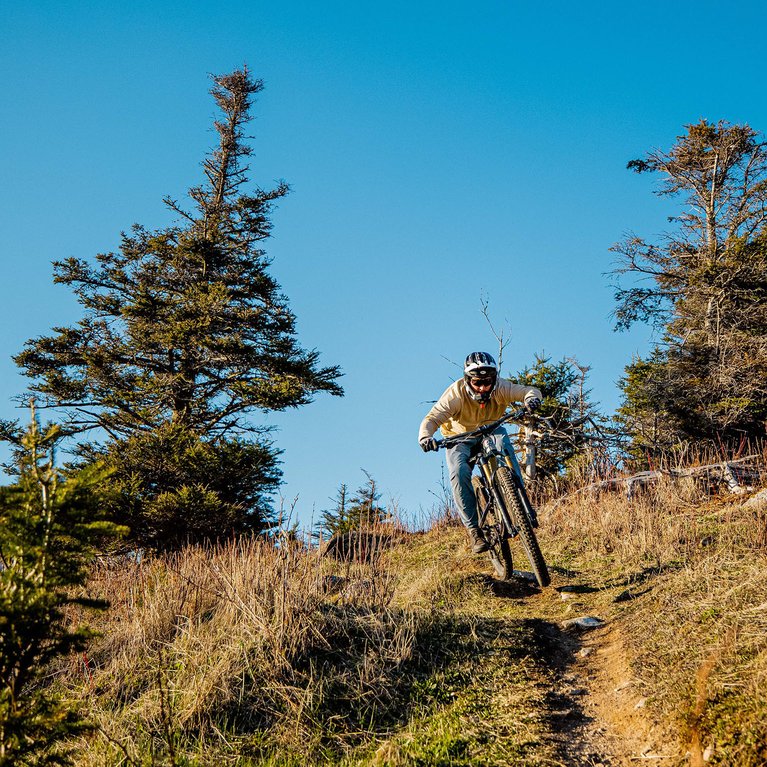
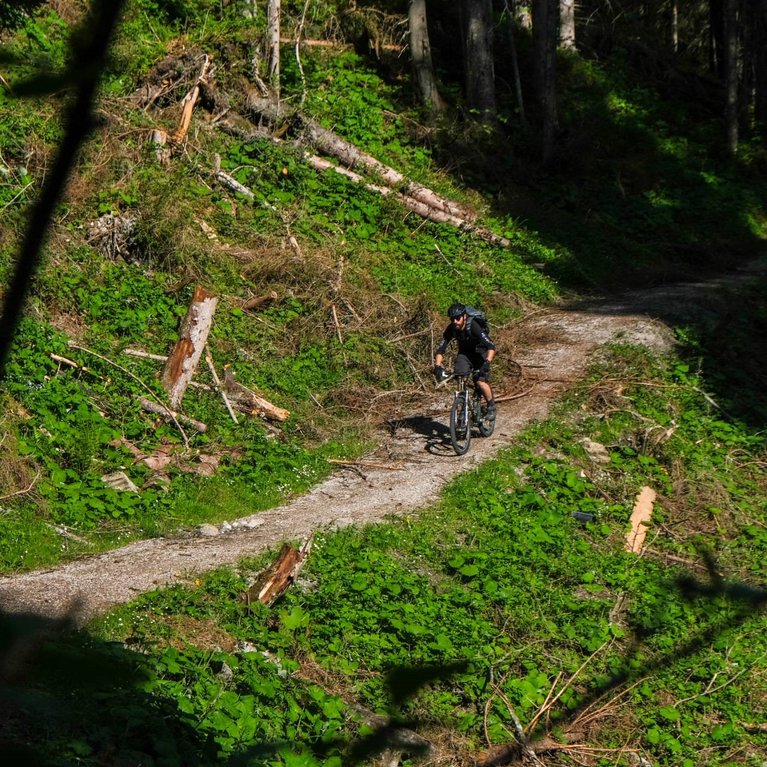
As a beginner, what should you consider when buying a mountain bike?
The most important thing is that the bike is a good match for you, and we don’t just mean the color. These days there are a multitude of different bike models for every purpose. Mountain bikes are therefore differentiated into the following categories:
- Cross-Country
- Trail
- All Mountain
- Enduro
- Freeride/Downhill
As you can see, this selection alone is very extensive, so it is best to make a list of where you would like to ride, what's important to you, and what you enjoy most.
To find the right bike, we strongly recommend that you have a specialist dealer assist you. Not only can they give you tips on which model is best for you, but also which material, frame size, seat position, and much more.
A good alternative to purchasing right away is to test out a couple different bikes first, so that you get a better feel for them. If you want to buy a used bike, be sure to ask someone in your circle of friends who knows a lot about mountain bikes so that you: A) don't pay too much, and B) select the right bike for you.
The right equipment for mountain biking:
In order to really enjoy mountain biking you don’t just need the right bike, but also the right equipment:
- Helmet: The most important thing first! Under no circumstances should you go without a helmet, because your head is one of the most important parts of the body and should be protected as much as possible. It is important that the helmet fits well and it certainly should not squeeze — so it is best to try out several models to find the perfect helmet for you.
- Glasses: You should definitely wear glasses for biking so that nothing gets in your eye on the descent and you are protected from UV rays. Interchangeable lenses can also be an advantage here – dark lenses to protect against the sun when riding uphill, and light lenses when riding downhill through the forest.
- Clothing: You can go biking with your usual sportswear, but clothing that has been specifically developed for mountain biking certainly has its advantages. You are perfectly equipped for spring and summer with bike shorts, a jersey, inner shorts with seat padding, and a thin rain jacket. For winter, you need a few warmer layers, such as a fleece pullover and long cycling pants.
- Shoes: First of all, you have to decide whether you want to ride with clipless pedals or flat pedals. Both systems have their advantages and disadvantages. It is best to try both and decide which system is best for you and your requirements. With clipless pedals, you need the right clipless shoes and with flat pedals it's best to have mountain bike shoes (such as Fiveten) that give you enough grip on the pedals.
- Gloves: Cycling gloves not only provide better grip, they also protect your palms.
- Backpack: A comfortable backpack with a capacity of around 20 liters is usually enough to store snacks, clothing, first aid kits, etc. It is important that the backpack fits well and can be adjusted using chest and hip straps so that it does not slide around when biking.
- Protectors: Knee and elbow protectors can be a real asset in the event of a fall and, since they are not particularly expensive, it is better to be on the safe side. If you like to go downhill very fast or do jumps, you should also consider a back protector.
- First aid kit: A fall can happen very quickly, so you should always have a first aid kit with you when biking.
- Repair kit: All it takes to get a flat tire is to run over a sharp object a single time. A repair kit is essential so that you can fix this quickly while on a ride and don't have to walk your bike home. This should include: Multitool with the most important tools, air pump, spare inner tube, inner tube repair set, and possibly a shift cable set as well as one or two chain links plus a new rivet pin.
Observe the proper riding techniques
Especially as a beginner, you tend to make certain mistakes that can really take a toll on your body. No one is born an expert and it takes some practice. With the following tips, you can avoid a lot of rookie mistakes from the start, and you will see that it gets easier every time:
1. Position your body correctly
Any riding technique is useless if you start off in the wrong basic position. Here's how it works:
- Take a horizontal pedal position.
- Position your feet correctly on the pedals by placing the balls of your feet directly in front of the pedal axis.
- Keep your knees and arms slightly bent to absorb bumps and shocks from rough terrain.
- Make sure your center of gravity is above the bottom bracket.
- Your back should stay straight.
- Place your index fingers on the brake levers so that you are always ready to brake.
2. Keep your eyes ahead
One of the most common mistakes when starting mountain biking is that you often look down instead of straight ahead. However, foresight is half the battle when it comes to mountain biking. So always keep your view far enough ahead to avoid falls.

3. Get out of the saddle
Even if it seems very comfortable at first to be in the saddle all the time, it can lead to falls, especially when riding downhill. Because when you are in the saddle, you aren't using one of your most important resources: your legs! Not only do they help you to absorb impacts better, but they also help you to better shift your weight. In addition, this lets you give your bike enough room so that you don’t impede its movement, especially on difficult terrain.
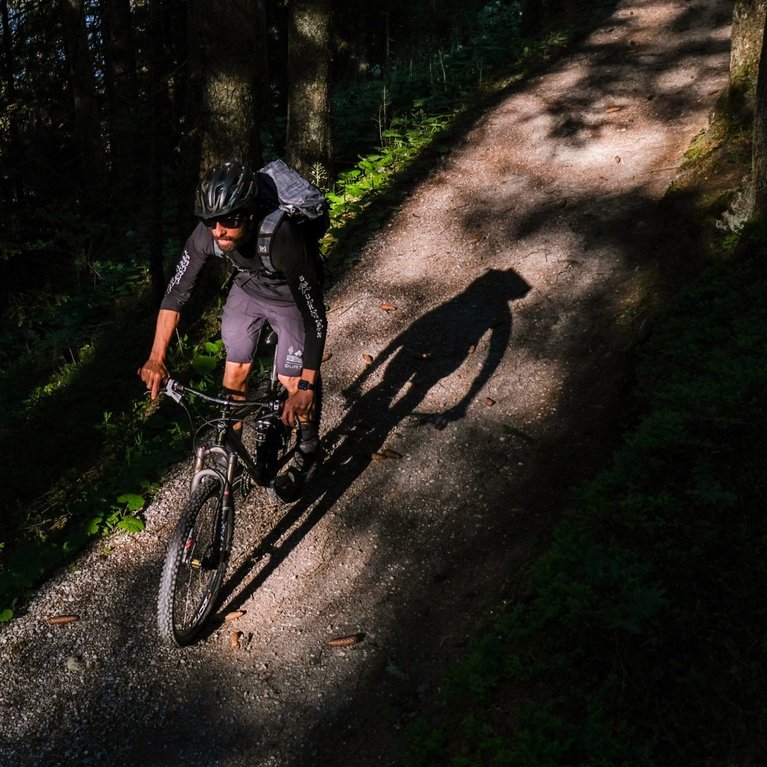
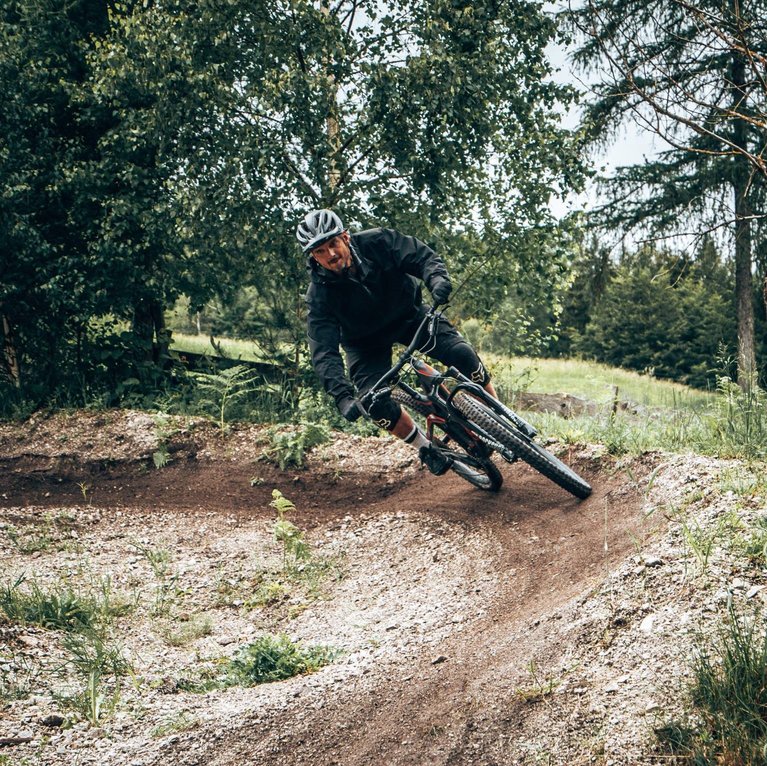
4. Use your brakes efficiently
Braking is not that easy and it requires a little practice to get the right feel for the braking force.
- The basic position is with one finger on each brake. The brakes should be set so that you can ideally operate them with one finger.
- Now you operate both brakes simultaneously with controlled force.
- At the same time, you shift your weight back and down so that the rear wheel does not lose traction.
- If possible, you should make sure that your weight is evenly distributed over both wheels so that neither wheel locks up.
- Maximum deceleration is reached shortly before the wheels start to lock.
Tip: When riding downhill, lower your saddle to shift the weight backwards and avoid flipping forward.

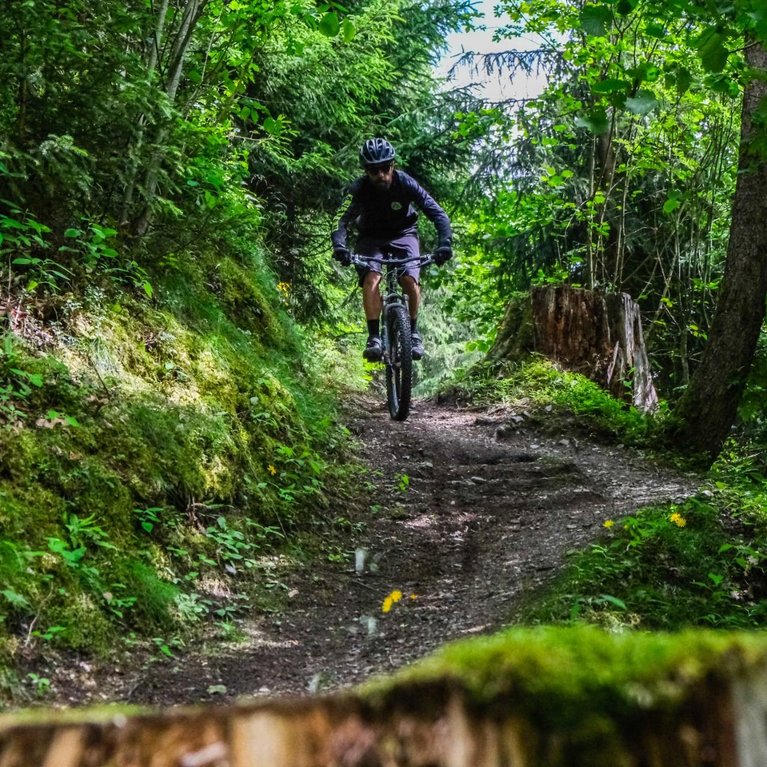
5. Shift into the right gear
Many people may think they are getting a better workout when riding in a harder gear, but the truth is that you are just needlessly expending your strength that way. Shifting into an easier gear not only makes it easier to accelerate, it also helps with navigating around curves and keeps you from becoming tired too fast.
6. Practice, practice, practice
One of the most important aspects in mountain biking is to practice. Try to have as much fun as possible, and don't put yourself under unnecessary pressure. You will see that it gets easier and easier each time, and you learn from your mistakes. So don't be afraid to try something new, because this is the only way to keep adapting and improving your technique.
7. Try out new terrain
Even if leaving your comfort zone seems difficult at first, it is usually extremely worthwhile, because this is the only way you can test your limits and develop your skills. As snowboarders, we love the speed and freedom that mountain biking offers.
Once you've had a taste, you’ll find out just how addictive this sport can be!
